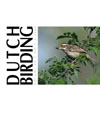Dutch Birding volume 28 (2006) no 5

Pallas's Grasshopper Warblers in Noord-Holland in September 2002-05
On 21 September 2002, 27 September 2002, 12 September 2003 and 20 September 2005, first-year Pallas's Grasshopper Warblers Locustella certhiola were trapped and ringed at Castricum, Noord-Holland, the Netherlands. On 30 September 2004, one was trapped and ringed 17 km to the south at Bloemendaal, Noord-Holland. These were the second to sixth records for the Netherlands and also for the coastal Kennemerland region of Noord-Holland. The only previous record concerned a first-year trapped on 5 October 1991, also at Castricum. There are 57-59 records in western Europe up to and including 2005. Two-thirds were in Norway and Shetland, and date between 10 September and 12 October; there are two August records for France and Germany. Based on photographs and biometrics, the bird of 2004 closely resembled the subspecies L c certhiola from western Siberia (like the one on Utsira, Norway, the same day). The birds of 1991, 21 September 2002, 2003 and 2005 closely resembled each other; they were slightly heavier streaked above than the Bloemendaal bird of 2004 but are still best considered as certhiola. The bird of 27 September 2002 was even less distinctly streaked than the Bloemendaal bird of 2004 and closely agreed with the subspecies L c centralasiae from eastern Kazakhstan, Xinjiang and Mongolia. Diagnoses of the subspecies, based on breeding birds examined and on literature, are presented. After examination of the type specimen of certhiola in Berlin, Germany, centralasiae, certhiola, rubescens and minor are used as names for the subspecies, following Sushkin (1925) and Cheng (1987), rather than centralasiae, sparsimstriata, rubescens and certhiola for the same taxa in the same order, as done by Meise (1934) and Stepanyan (2003). The subspecies centralasiae, certhiola and rubescens grade into each other where they meet, but the subspecies minor is markedly smaller than the three others (wing male 61-67 mm, female 58-63, against male 66-74 and female 63-69 in skins of the others), is said to have a different voice (Stegmann 1929) and may overlap locally with rubescens in breeding range, and thus may form a separate species. However, it apparently grades into certhiola in south-eastern Transbaikalia, eastern Mongolia and the neighbouring part of northern Inner Mongolia, as birds from these areas combine the pale ground colour of minor with the moderate dark streaking of certhiola and have an intermediate size.
C S (Kees) Roselaar, Zoölogisch Museum, Universiteit van Amsterdam, Postbus 94766, 1090 GT Amsterdam, Nederland
( roselaar![]() science.uva.nl)
science.uva.nl)
Arnoud B van den Berg, Duinlustparkweg 98, 2082 EG Santpoort-Zuid, Nederland
(arnoud.vandenberg![]() planet.nl)
planet.nl)
André J van Loon, Kastelenstraat 45-2, 1083 CB Amsterdam, Nederland
(loon-gavia![]() planet.nl)
planet.nl)
Erik Maassen, Wijk aan Zeeërweg 180, 1972 NW IJmuiden, Nederland
(erik.maassen![]() zonnet.nl)
zonnet.nl)
terug






